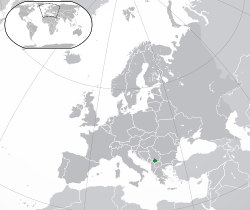Current literature indicates five sets of numerically recorded deportations from Kosovo:
1) August 1941, Mitrovica, under German occupation, 88 Jews are reported to have been sent to Sajmište Concentration Camp near axis occupied Belgrade where they were killed. Prior to deportation all Jewish men in Mitrovica / Mitrovice are alleged to have been arrested, while women were sent to daily forced labor. In February 1942, the women are said to have been detained with their children, Jewish property taken by local collaborators, and the synagogue destroyed. A 1960 report to the Administration of the State Security of NR Serbia details names of victims from 12 families shot at the camp in winter 1941. [5]
[Source [5] can be crossed referenced with second generational verbal accounts of deportations from Mitrovica that can still be sourced today. Supplementary survivor testimony in the Shoah Foundation Archive also makes reference to experience of the holocaust in relation to movements through Kosovska Mitrovica]
2) 1942, Prishtina. 250 Yugoslavian Jews, including an unknown number of native Kosovo Jews, transferred to the Albanian interior. As of 1943 historian Daniel Perez relates they made up part of 500 Jews held under house arrest or in concentration camps in the Albanian towns of Berat, Kruja and Kavaja. He also indicates movements of both native and non-native Jews from Kosovo to Albania were ongoing throughout the war period. [6]
3) March 1942, Prishtina. Italian military police detained 51 Jewish refugees and passed them to the Nazis. According to historian Noel Malcolm they were sent to Sajmiste. Daniel Perez details that the deportation list was compiled by Italian authorities and local Albanian police and that they were first sent to a "concentration camp" [probable terminiological error - as it was a holding camp] in Prishtina before being transferred to Mitrovica. [5] [6] [7]
4) May 14, 1944, Prishtina. Nazi Chief Heinrich Himmler organized the Skanderburg Unit which were commanded by the Germans to arrest 281 Jews who were sent to Bergen-Belsen via occupied Belgrade where, according to Noel Malcolm, 'more than' 200 died, or according to Martin Cüppers, 'at least' 177 died. [7] [6] [8] [9]
5) August 1944, Prishtina, An extensive list of 789 mainly non-Jewish victims including Bosniak, Albanian, Serbian, communists, partisans and activists, arrested by the SS Skanderburg division to be transported to the Reich has been published by Robert Elise. 31 people are listed as Jews, and a further 11 people, mainly children, are listed purely on the basis of belonging to a Jewish family. Their fate is unknown. [10]
Though the majority of historians seem to draw consensus around the 281 figure Albanian historian Haxhi Bajraktari is said to have written that only 43 Jewish names were included in a total of 249 deportees, whom he describes as mainly Communists and Partisans. [11] Analysis of apparently original Nazi transport lists [ usurped ] suggest Bajraktari's apparent figures for Jews to be understated. Serbian historian Pavle Dzeletovic Ivanov also puts the number of arrests on May 14 at 400 (which conversely suggests overstatement). [12] The names of those who both survived and perished at Bergen-Belsen are recorded at source [5]
Noel Malcolm summarises that out of 551 native Kosovo Jews present before war, 210 had died by the end. [7] This does not correspond numerically with the full evidence above. The true number therefore remains unknown.
Video interviews with Kosovo Jews who survived the Holocaust can be found at the Shoah Foundation.
Extensive testimonies and photographs can be found at the USA Holocaust Museum website. [13]
An extract from the statement of Hedviga Schönfein, prisoner of the Judenlager Zemlin (Sajmište) prison camp has been published by the Centre for Democracy and Reconciliation in South East Europe:
"Immediately upon our arrival at the camp, the Germans told us that the camp would gradually be evacuated, because they intended to imprison communists at the Fair, but they did not want to tell us where they were going to take us.... For the first transfers they invited volunteers and the first to be invited was the group I was from – Jews from Kosmet. (...) Those who were designated for transport were ordered, or, more precisely, kindly advised to take their most valuable possessions with them, and to pack all the rest carefully and put their exact address on the package. (...) Thus, these transfers departed almost every day. On Sundays and holidays there were usually no transfers or removals, but there were days when the car would make two rounds. The driver of the grey car often entered the camp alone, gathered children around him, caressed them, took them in his arms and gave them candies. The children liked him and whenever he came, they would rush toward him to get candies. No one in the camp suspected that people were taken to their deaths. It was strongly believed they were being transferred into a work camp." [14]
A statement [ usurped ] from Albert Ruben suggests a deportation from Prishtina in winter 1943, not recorded by the academic historians above:
"At the end of 1943, it was already winter, maybe November or December, the SS men came to all Jewish homes to round us up. They got us out of our beds and took us straight to the barracks near the football field. There were a lot of us, more than four hundred people. We stayed there for two days. Everyone brought some food with them. We didn't have a toilet, so we dug a hole and put some wooden boards over it. They were threatening us, telling us to hand over our gold and other valuables, and we were throwing them into the toilet. What we had not given to the poor earlier we were now throwing into the toilet. Before long they put us into cattle wagons and drove us to the Belgrade camp for Jews at the Sajmiste."




